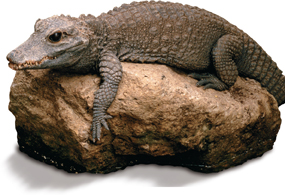The first loop, powered by one side of the heart, forces oxygen-poor blood from the heart to the lungs. After the blood picks up oxygen (and drops off carbon dioxide) in the lungs, it returns to the heart. Then, the other side of the heart pumps this oxygen-rich blood through the second circulatory loop to the rest of the body. Oxygen-poor blood from the body returns to the heart, and the cycle begins again.
Mammalian Heart-Chamber Evolution Four-chambered hearts like those in modern mammals are actually two separate pumps working next to one another. But where did the second pump come from? During chordate evolution, partitions evolved that divided the original two chambers into four. Those partitions transformed one pump into two parallel pumps. The partitions also separated oxygen-rich blood from oxygen-poor blood. We can get an idea of how the partitions evolved by looking at other modern vertebrates.
MYSTERY CLUE

Human blood is only about a third as salty as seawater. It needs to circulate through very small capillaries. What might happen if the water content of a person's blood were to drop too low?
Amphibian hearts usually have three chambers: two atria and one ventricle. The left atrium receives oxygen-rich blood from the lungs. The right atrium receives oxygen-poor blood from the body. Both atria empty into the ventricle. Some mixing of oxygen-rich and oxygen-poor blood in the ventricle occurs. However, the internal structure of the ventricle directs blood flow so that most oxygen-poor blood goes to the lungs, and most oxygen-rich blood goes to the rest of the body.
Reptilian hearts typically have three chambers. However, most reptiles have a partial partition in their ventricle. Because of this partition, there is even less mixing of oxygen-rich and oxygen-poor blood than there is in amphibian hearts.

FIGURE 27–12 Reptilian Heart Under the armor-like hide of this crocodile lies a heart with two atria and one ventricle.
27.3 Assessment

-
Review Describe an open circulatory system. Describe a closed circulatory system.
Explain Which groups of animals tend to have each type of circulatory system?
Relate Cause and Effect How does having a closed circulatory system benefit a large, active animal?
-
Review What are two different patterns of circulation found in vertebrates?
Compare and Contrast What is the major structural difference between vertebrates that have single-loop circulatory systems and those that have double-loop systems?
Apply the Big idea
Do you think large, active vertebrates would have been likely to succeed if closed circulatory systems had not evolved? Explain your reasoning.

Table of Contents
- Formulas and Equations
- Applying Formulas and Equations
- Mean, Median, and Mode
- Estimation
- Using Measurements in Calculations
- Effects of Measurement Errors
- Accuracy
- Precision
- Comparing Accuracy and Precision
- Significant Figures
- Calculating With Significant Figures
- Scientific Notation
- Calculating With Scientific Notation
- Dimensional Analysis
- Applying Dimensional Analysis




